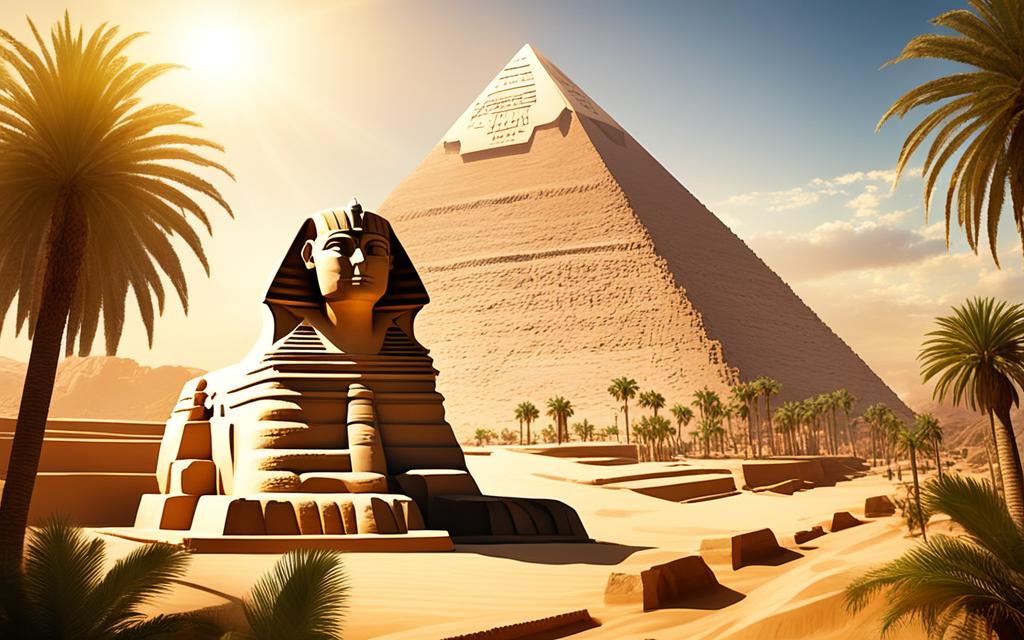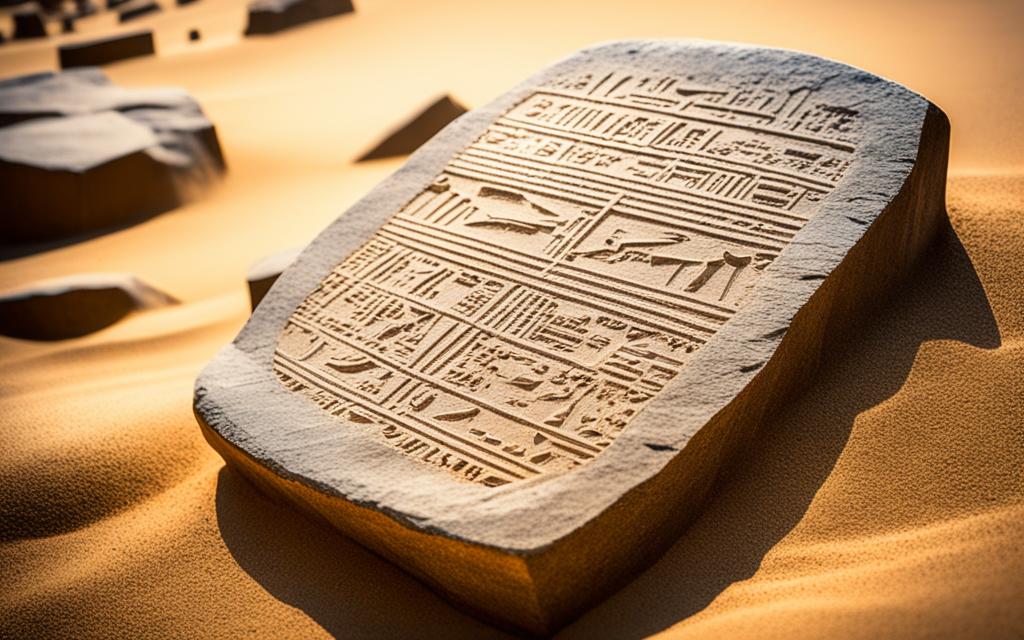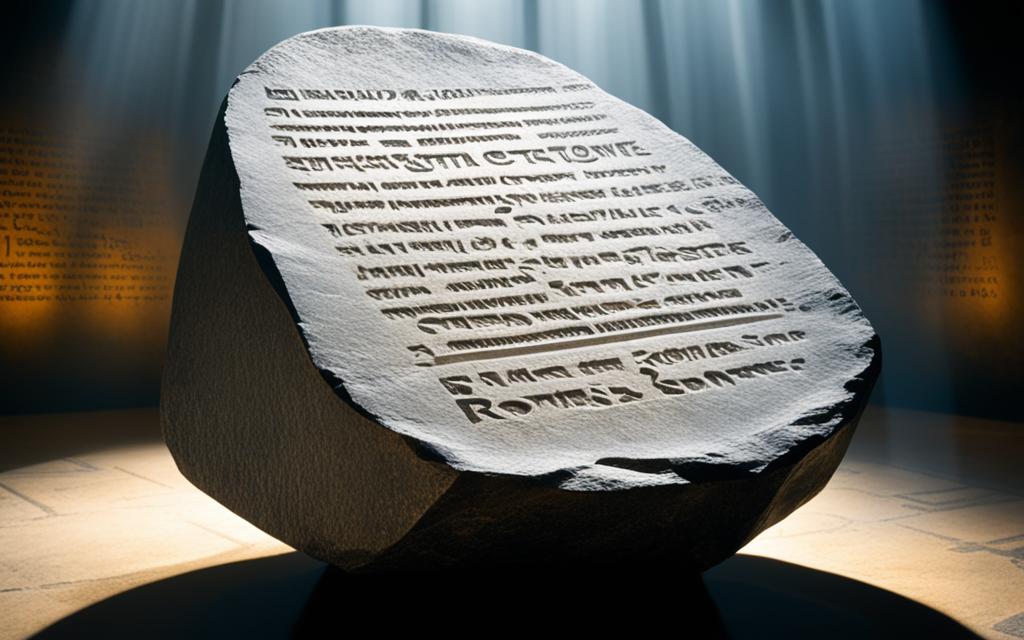Imagine being in front of a huge monument. It looks old, but its surface tells stories from centuries ago. This is the Rosetta Stone. This ancient Egyptian artifact has intrigued both scholars and the public. It has been a key piece in understanding hieroglyphics, an ancient language that was once a mystery.
Discovered in 1799, the Rosetta Stone changed the game for both linguistics and archaeology. Its writings are in three scripts: ancient Egyptian hieroglyphs, Demotic script, and ancient Greek. This made it possible to unlock the secrets of ancient Egyptian texts for the first time.
Jump into the story of this amazing artifact. You’ll be on a journey through time, discovering how it has helped us explore ancient cultures. The Rosetta Stone stands as a symbol of our endless curiosity about history.
Key Takeaways
- The Rosetta Stone is a remarkable ancient Egyptian artifact that played a crucial role in unlocking the secrets of hieroglyphic writing.
- The stone’s multilingual inscription, featuring ancient Egyptian hieroglyphs, Demotic script, and ancient Greek, provided the key to deciphering long-lost languages.
- The Rosetta Stone’s significance extends beyond its linguistic importance, as it sheds light on the rich cultural heritage of ancient Egypt and has inspired ongoing research and exploration.
- The decipherment of the Rosetta Stone’s inscription was a groundbreaking achievement, enabling scholars to access a wealth of ancient Egyptian texts and deepen our understanding of the past.
- The Rosetta Stone continues to captivate the public’s imagination and inspire new avenues of linguistic research and cultural exploration.
The Rosetta Stone: A Linguistic Marvel
The Rosetta Stone amazes both scholars and the public. It has an inscription in three scripts: ancient Egyptian hieroglyphs, Demotic, and ancient Greek. This multilingual inscription was key in solving the mystery of hieroglyphs.
Unveiling the Mysteries of Hieroglyphs
Linguists compared different scripts to understand hieroglyphs. The Rosetta Stone’s multilingual inscription unlocked their meaning. This find revealed much about ancient Egyptian history and culture.
The Multilingual Inscription’s Significance
The Stone’s multilingual inscription is a unique example of ancient text preservation. It kept the same message in three writing systems. This made it possible to later understand ancient Egyptian writing.
Ancient Egypt’s Enduring Legacy
The Rosetta Stone bridges us with the profound cultural glory and historical weight of ancient Egypt. This famed stone highlights Egypt’s sophisticated culture and administrative methods. It also unveils their diverse languages and religious beliefs. With these, we glimpse into the vibrant world of the ancient Nile Valley. The Rosetta Stone stands as a beacon of Egypt’s lasting influence. It continues to fuel curiosity about the nation’s ancient days.
The Rosetta Stone is key in understanding Egyptian culture and history. It goes beyond helping to decipher ancient scripts. The stone gives us a peek into the diverse and rich culture of ancient Egypt. Thus, it opens a window to the achievements of one of the earliest and most impactful civilizations.

The Rosetta Stone still catches the interest of many. It sparks a lasting intrigue into the cultural heritage and historical significance of ancient Egypt. The stone’s influence stands as a tribute to the power of language. It also celebrates our never-ending wonder with the unknowns of history.
Deciphering the Rosetta Stone
The Rosetta Stone’s decryption was big news in linguistics and archaeology. It was found again in 1799, sparking a worldwide puzzle-solving spree. In the 1820s, Jean-François Champollion, a French scholar, cracked the code. He looked at both the Greek and hieroglyphic texts to figure it out.
Champollion’s work marked a turning point. He showed that some hieroglyphs stood for sounds, others for ideas. This understanding opened up a whole new way for us to learn about ancient Egyptian life and times.
The Rosetta Stone: A Key to Translating Ancient Languages
The Rosetta Stone is a key that helped us understand lost civilizations. It opened doors to translating ancient languages like never before. This ancient artifact was the first to show the same text in different languages.
With this information, experts could finally read ancient Egyptian scripts, from tales of the gods to day-to-day notes. The stone is like a bridge to the past, unlocking ancient texts and secrets.
Unlocking the Doors to Lost Civilizations
Thanks to the Rosetta Stone, we now understand the never-been-understood parts of ancient Egypt. But its effects reach far beyond just one culture. It’s changed how we see all lost languages as well.
This key has illuminated the hidden stories of many past societies. Because of the Rosetta Stone, we can read their ancient words, not just guess at their meanings.
The Impact on Language Learning and Translation
The Rosetta Stone has not only helped with ancient languages. It’s also made modern language learning better. Thanks to the Stone, we’ve found new ways to study both old and new tongues.
This breakthrough has updated the ways we learn and translate. It’s given us valuable methods for understanding different languages. Today, we still use these lessons to learn new languages.
Preserving the Rosetta Stone
The Rosetta Stone is a priceless historical artifact. It has seen a lot of conservation efforts to keep it safe for the future. It was found a long time ago and now rests at the British Museum in London. Over the years, it has been carefully checked and restored to avoid damage from time and the environment.
Conservation Efforts and Modern Accessibility
In recent times, the museum has worked hard to make the Rosetta Stone more accessible to everyone. They have added digital tech and interactive displays. Now, people can learn and interact with this important piece of history up close. These efforts show the ongoing promise to protect and share the Rosetta Stone’s value with people worldwide.
The Rosetta Stone’s Enduring Fascination
The Rosetta Stone is endlessly fascinating. It has captured the public’s interest and fueled research into ancient languages, cultures, and civilizations. Its discovery and the subsequent translation of its words have intrigued scholars and the public. They have led to a new wave of interest in ancient times.
Inspiring Curiosity and Exploration
The Rosetta Stone sparks curiosity and a quest for past secrets. As a result, people have made new archaeological discoveries and learned more from linguistic analyses. This has broadened our knowledge of Egypt’s rich history and other ancient cultures.
Ongoing Research and Discoveries
The Rosetta Stone continues to be a source for research and exploration today. Scholars are still finding out more about its cultural, historical, and linguistic importance. This ensures it remains a significant part of our understanding of the past.

Conclusion
The Rosetta Stone is a big deal because it helped us understand ancient Egyptian culture, history, and language. This ancient artifact is key to unlocking the past. It is a symbol of the deep, rich history of the Nile Valley.
This special stone continues to wow both experts and people like us. It remains a source of wonder and insight into ancient times. The Rosetta Stone highlights the curiosity and drive in all of us to learn.
The Rosetta Stone is not just about understanding old languages. It’s a symbol of how much we value our history and culture. It will keep inspiring future generations to explore and learn about our shared past.




